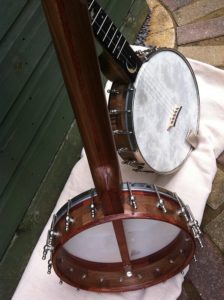Though there are many differentiating factors when it comes to types of banjos, including the number of strings, the makeup of the materials, etc.
There is no defining feature so divisive in the banjo world as the difference between the open back or resonator types.
Table of Contents
- Differences Between Open Back Banjos and Resonator Banjos
- Should you get a open back or resonator banjo?
- What does a banjo resonator do?
- Can you add a resonator on a open back banjo?
- Can I take the resonator off my banjo?
- Conclusion
Differences Between Open Back Banjos and Resonator Banjos
Resonator
Resonator banjos have an extra physical part, known as the resonator, which is a bowl shaped part affixed to the back of the pot of the banjo.
This gives resonator banjos a louder sound, which is commonly used in bluegrass music since it’s the banjo that stands out as being a lead instrument in that particular style of music.
Open Back
Open back banjos tend to be slightly more subdued in their tone, making them better suited to the clawhammer style of playing banjo.
This lower volume is due to the loss of sound from the back of the sound chamber, or pot, whereas a banjo with a resonator projects the sound forward, towards the people you are playing for.
Sound
Pick up an open back or resonator banjo, pluck a few notes or chords, and immediately you’ll hear that the tonal qualities are quite different between the two.
Which one is better? The answer to that question depends on the type of music you’re playing.
Clawhammer banjo players prefer the tones of the open back banjo, since the style of play is often with other instruments playing, and the banjo doesn’t need the instrument at the forefront of the music.
Bluegrass banjo players tend to prefer the resonator type of banjo, since the added twang sound, not to mention the added volume, both go a long way in pushing the sound of the instrument to the forefront of any particular bluegrass tune.
The sound is brighter on the resonator banjo than it is on an open back banjo, which tends to be somewhat mellow by comparison since some of the sound is lost by way of the open back on the pot of the instrument.
Weight
It might be obvious knowing that there is an extra significantly sized physical part on a resonator banjo which is missing from an open back banjo, but it’s worth noting that closed back banjos are usually a fair bit heavier than open back banjos because of this difference.
Lightweight banjos have their place, for example models meant for travelling are often the naturally lighter weight open back version of the instrument.
Price
Price is probably the first thing you’ll notice when comparing open back or resonator banjos.
Open back banjos tend to be slightly less expensive than resonator banjos are, mainly because there is less material and therefore slightly less manpower going into the manufacture of the instrument.
String Position
String placement is usually, but not always, slightly higher on open back banjos.
This is because the style of music most often played on open back banjos is the clawhammer style, which uses a different picking method when compared to bluegrass banjo playing.
You’ll find that most resonator banjos, as a result, have strings placed lower to the neck and body of the instrument, which helps to facilitate the picking style of bluegrass banjo players.
Should you get a open back or resonator banjo?
Beauty is in the eye of the beholder, and in this case, it’s in the ear of the banjo player. But the decision between open back or resonator banjo is made easier if the type of music to be played is taken into consideration.
As mentioned above, if you intend to play bluegrass music, you’re probably best selecting a resonator banjo, for the louder, twangier sound most commonly associated with that style of music. See the best bluegrass banjos here.
If you plan to play the old time clawhammer type of music, your best bet is to select an open back banjo.
In either case, buy the best banjo you can afford, and try as many models as you can get your hands on before committing to one or the other.
Most importantly, familiarize yourself with the types of music played on this unique and wonderful instrument, and choose an open back or resonator banjo to suit the kind of music you’re going to love playing for many years to come.
What does a banjo resonator do?
The resonator on a banjo mainly raises the volume to produce a much louder outward sound which is great for audiences.
Can you add a resonator on a open back banjo?
You can but not all open back banjos can. So make sure that yours can and also make sure it will be worth it.
Sometimes it’s just worth getting a proper resonator banjo to get the perfect sound that you want.
Can I take the resonator off my banjo?
Yes you can take off the resonator but will most certainly make the sound a bit off a quiet.
Make sure you get the owners manual to make sure you do it correctly or watch a Youtube video.
Conclusion
Understanding the differences between an open back banjo and closed back (resonator) banjo is critical to knowing what type of music you want to play and ultimately which type of banjo that you should get.
Image from flickr creative commons plenty.r.



